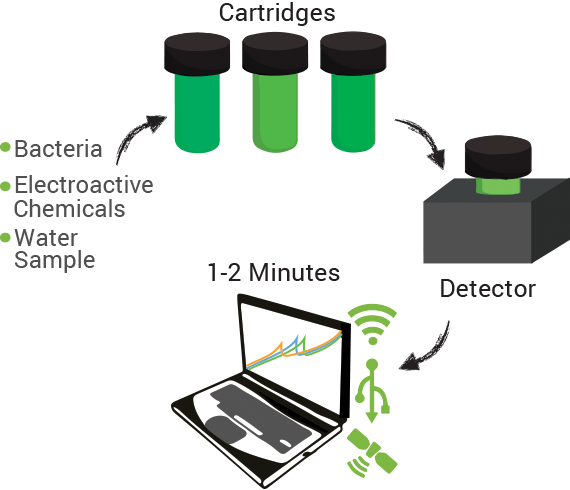Team:Calgary Entrepreneurial/Project/Technology/
From 2013.igem.org
{{Team:Calgary_Entrepreneurial/BasicPage |SIDENAV=
|ABSTRACT=
Developing the Technology
Bla bla bla bla bla bla bla bla bla bla bla bla bla
|CONTENT=
Overview
Our product is a toxin sensor for detecting a variety of oil and gas related contaminants in water supplies. The system is portable, on-site, and rapid allowing for monitoring of toxins in the environment much more quickly and easily than present systems allow. It uses a strain of Pseudomonas which has been synthetically designed to react to numerous toxins in the environment. These toxins result in the production of enzymes capable of producing electro-active compounds. Our system detects these electroactive chemicals and measures the amount produced using a simple computer, USB, WiFi, or GPS based interface.
Presently we have shown our strain to be able to detect three relevant oil sands toxins (naphthenic acids, carbazole, and dibenzothiophene) and that it does not react to other stresses such as hydrogen peroxide or healthy compounds (decanoic acid). We have demonstrated that we can measure the production of our electrochemical analytes and working to demonstrate that we can use multiple enzyme/electroactive compounds simultaneously to make our system more effective. Therefore, we have a proof-of-concept technology which will require further refinement prior to developing a prototype system.
Technical Description of the Technology
Sensing Microorganism:
A transposon screen using an electrochemical reporting enzyme (lacZ) was performed on Pseudomonas fluorescens Pf-5 (a native tailings pond organism shown to degrade oil sands toxins), and strains were found which respond to general oil sands toxins (sulfur-heterocycles, nitrogen heterocycles, and naphthenic acids were specifically shown to elicit a response higher than baseline, without responding to general hydrocarbon compounds and stress agents). This response consisted of production of a reporter enzyme capable of cleaving a substrate which could then give an electrochemical response. Further testing on one strain using actual tailings pond samples showed a higher than baseline response, and the organism was capable of survival in the toxic substrate. The sensing elements themselves have not been identified or characterized as of yet, and the system has yet to be multiplexed, providing only one output for general toxin response.
[[File:170-1data.png|550px|left|thumb|Figure 1 - Toxin Sensing Strain detects tailing pond toxins in commercial and real samples. (Left) X-Gal blue-white screening assay. Cells were inoculated in duplicate at different dilutions into LB as a control, and LB containing different toxin compounds at environmental concentrations. Absorbance was read at 615nm (maximal absorbance of X-gal) every hour. (Right) Current change over time illustrating lacZ induction by our identified transposon sensory element in a tailings pond water sample. Phosphate Buffer Saline (PBS) was used as a base-line negative control.][File:UOFCTailingsPondWinData!.png]<html|300px|right|thumb|]>
Electrochemical Enzymatic Reporting System:
The oxidation potential chlorophenol red (CPR), para-diphenol (PDP), and para-nitrophenol (PNP) as substrates was tested. These compounds are conjugated with their sugars to form CPR-β-D-galactopyranoside (CPRG), PDP-β-D-glucopyranoside (PDPG), and PNP-β-D-glucuronide (PNPG). It was found that when measured using cyclic voltammetry, the oxidation potentials of the three substrates were distinct and could be visualised separately on the resulting graph, showing the potential for multiplexing the system.
Three hydrolase enzymes were identified which have been shown to act on these substrates; beta-D-glucoside glucohydrolase (bglX gene), beta-glucuronidase (uidA gene), and beta-galactosidase (lacZ gene). Commercial versions of these enzymes were tested and it was shown that by cleaving their substrates an electrochemical signal could be detected by a potentiostat. These enzymes were put into standardized plasmid backbones for expression in Escherichia coli under control of an inducible promoter for testing.
</html>
}}
 "
"
